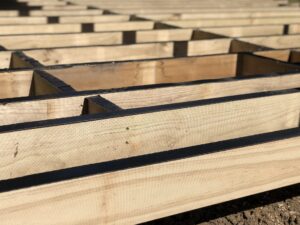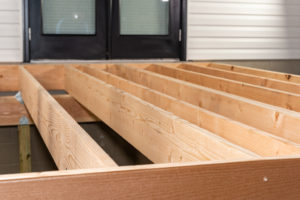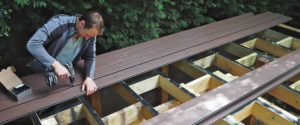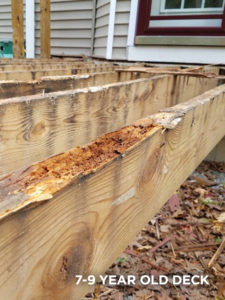Bearers and Joists: The Backbone of a Sturdy Deck
By Dave Kile When building a deck, one truth always holds: if your substructure isn’t solid, nothing above it will be either. That’s why I pay careful attention to the bearers and joists that form the backbone of every deck. Get those right, and you’ve set your project up for long-term success.
When building a deck, one truth always holds: if your substructure isn’t solid, nothing above it will be either. That’s why I pay careful attention to the bearers and joists that form the backbone of every deck. Get those right, and you’ve set your project up for long-term success.
Here, I’ll walk you through what bearers and joists do, how they work together, and how to install and protect them properly for a deck that lasts for years to come.
What are Bearers and Joists?
Deck bearers are the main horizontal supports that typically span between posts or piers. They carry the weight of the joists, as well as everything above them, down into the footings.
Joists run perpendicular to the bearers and support the decking boards. Together, they form the essential framework that spreads weight evenly and helps keep your deck flat, level, and strong.
Why Bearers and Joists Matter in Deck Construction
As the underlying structure of your deck, bearers and joists perform several vital functions that directly impact its stability and lifespan. Here’s why they’re so important:
Structural Support
 A deck’s stability starts with its framework. Bearers and joists form the primary load-bearing grid that supports the deck’s weight and keeps it secure. This includes:
A deck’s stability starts with its framework. Bearers and joists form the primary load-bearing grid that supports the deck’s weight and keeps it secure. This includes:
- Live loads: Variable weight from people, furniture, and movable objects.
- Dead loads: Fixed weight of the deck structure itself, including decking boards, railings, and stationary features like hot tubs or planters.
If bearers or joists are undersized, improperly spaced, or made from inadequate materials, your deck may bounce, sag, or fail completely.
Ventilation and Drainage
Properly spaced bearers and joists provide airflow that helps water dissipate from beneath the deck, reducing the risk of rot and decay. This is especially critical for decks built low to the ground or in high humidity.
Load Distribution
A vital role of bearers and joists is weight distribution across the deck structure. Joists transfer the weight of the decking surface to the bearers, which then deliver that load evenly to the footings. This balanced distribution prevents:
- Warping: Deck boards twisting or bending.
- Cupping: Boards forming a concave shape.
- Creaking: Noisy and unstable movement in the decking.
When properly installed, this support helps your deck remain level, stable, and free from stress-related damage.
Installation Tips
Choosing Quality Materials
For timber framing, I recommend treated hardwood or structural pine. For most deck designs, H3-rated timber for above-ground use provides strong defence against rot, decay, and insect attack. Consider an H4 rating for low-lying decks if your structure will be in near-contact to the ground.
I avoid low-grade softwoods; they’re prone to twisting and decay, especially on sloping or damp sites. Ultimately, investing in higher-quality timber will help your bearers and deck joists last, extending your deck’s lifespan.
Proper Spacing and Alignment
 Use Australian Standard AS 1684 or manufacturer specs to guide spacing:
Use Australian Standard AS 1684 or manufacturer specs to guide spacing:
- Joist spacing is commonly 450mm or 600mm centres.
- Bearer spans vary by timber size and load class, but must always support joists without excessive flex.
Always take the time to check for level and squareness at each step before moving on. I find this is a case where a few extra minutes in the moment saves hours later.
Use of Correct Fasteners
Outdoor elements are tough on fasteners. I use hot-dip galvanised or stainless steel screws and brackets to prevent rust, especially in coastal or damp areas. Never cut corners here: cheap fixings are a recipe for corrosion and movement.
I also recommend applying Trex Protect tape to the tops of beams and joists; it self-seals around fasteners, keeping water out and fixings tight.
Common Issues and Solutions
Sagging Floors
If your deck feels springy or slumps, I can almost guarantee the joists are undersized, over-spanned, or deteriorating. Start by inspecting the joists for cracks or soft spots and consult the applicable span tables, then reinforce or replace as needed.
Shifting or Misaligned Bearers
This is a problem I’ve seen many times, especially on sloping blocks with inadequate footings. If the posts aren’t properly anchored and adequately sized for the load, or the bearers aren’t securely fastened to the posts, alignment can shift and throw off the entire frame. Check for properly-sized footings or piers and always verify post spacing and bearer level. Use quality fasteners to ensure connections are square, strong, and locked in place.
Moisture Damage and Rot
 Timber bearers and joists are particularly vulnerable at connection points. Water trapped under decking boards or in fastener holes can slowly eat away at the wood, and it can go unnoticed until the damage is advanced. That’s why I always tape joist and bearer tops with Trex Protect before laying boards. It’s a simple step that prevents costly repairs later.
Timber bearers and joists are particularly vulnerable at connection points. Water trapped under decking boards or in fastener holes can slowly eat away at the wood, and it can go unnoticed until the damage is advanced. That’s why I always tape joist and bearer tops with Trex Protect before laying boards. It’s a simple step that prevents costly repairs later.
For more information, here’s my breakdown of what joist tape does and why I don’t build without it.
Australian Standards and Regulations
For safety and compliance, always follow Australian Standard AS 1684 for timber framing and AS 1720 for structural design. These standards cover:
- Timber span tables
- Fixing methods
- Minimum clearances and treatment levels
The guidelines can be purchased at the Standards Australia Store. For free access to key requirements and applications, check out NCC 2022 Volume Two – Housing Provisions and the HIA Guide to Timber Framing Using AS 1684.
Conclusion
Bearers and joists might not get the glory, but they’re doing the heavy lifting for your deck. Take the time to get them right by choosing quality timber, spacing and aligning it carefully, and protecting it from moisture from day one.
When you’re building a deck, you’re building something meant to be enjoyed for years. And it all starts with a strong support system underneath.
Sources
Handyman Magazine, How to plan and build a deck https://www.handyman.net.au/articles/how-to-plan-and-build-a-deck/
Housing Industry Association, Guide to Timber Framing Using AS 1684 https://hia.com.au/resources-and-advice/building-it-right/australian-standards/articles/using-as-1684-for-timber-framing
Timber Development Association, Domestic Timber Deck Design Guide https://cms.itiaustralia.com.au/uploads/Decking_Guide_9961f7f39a.pdf
Trex, How to space and install deck joists https://au.trex.com/academy/how-to-guides/all-guides/how-to-install-deck-joists/